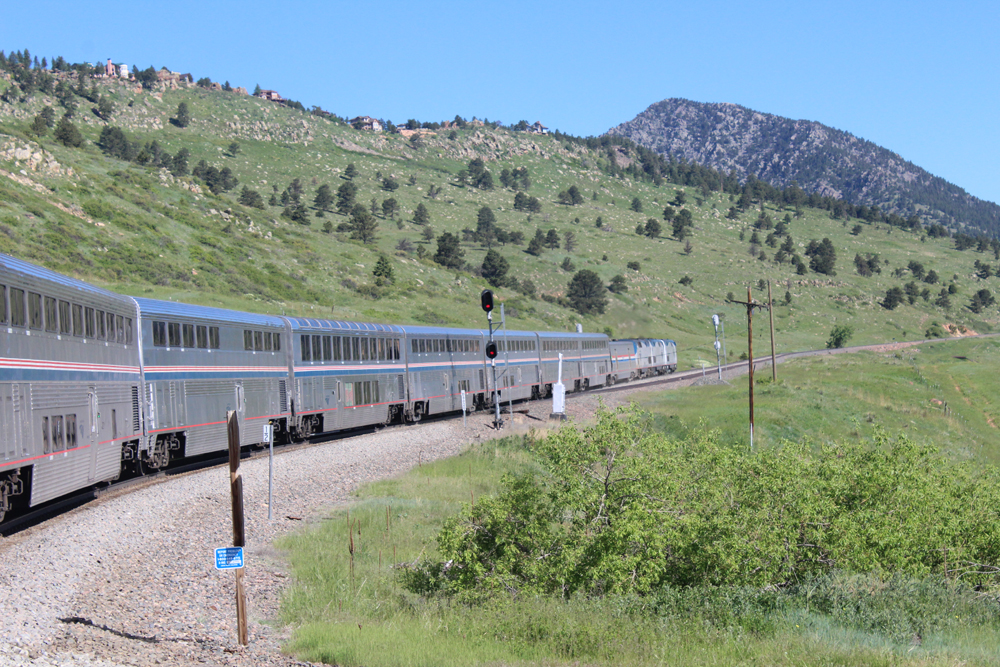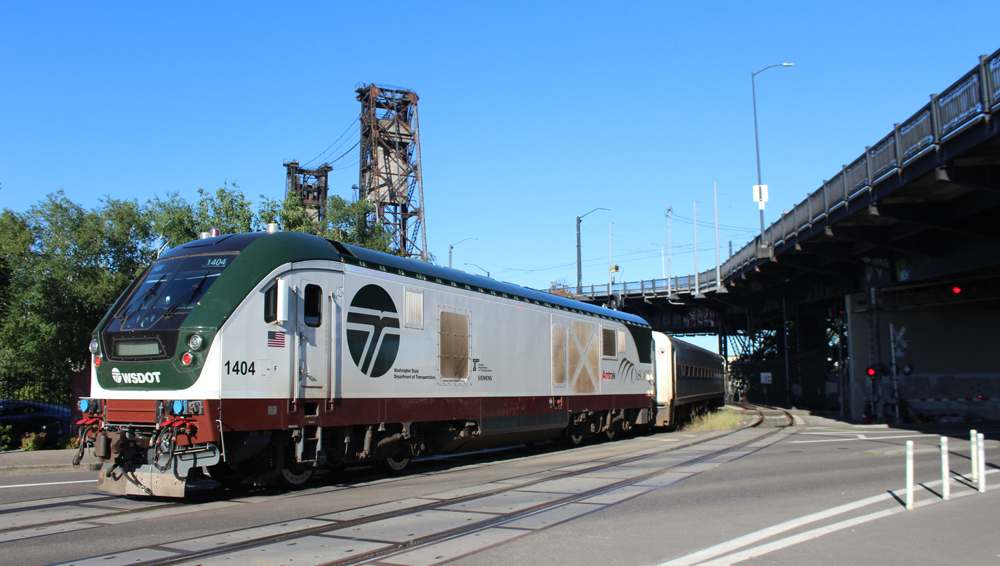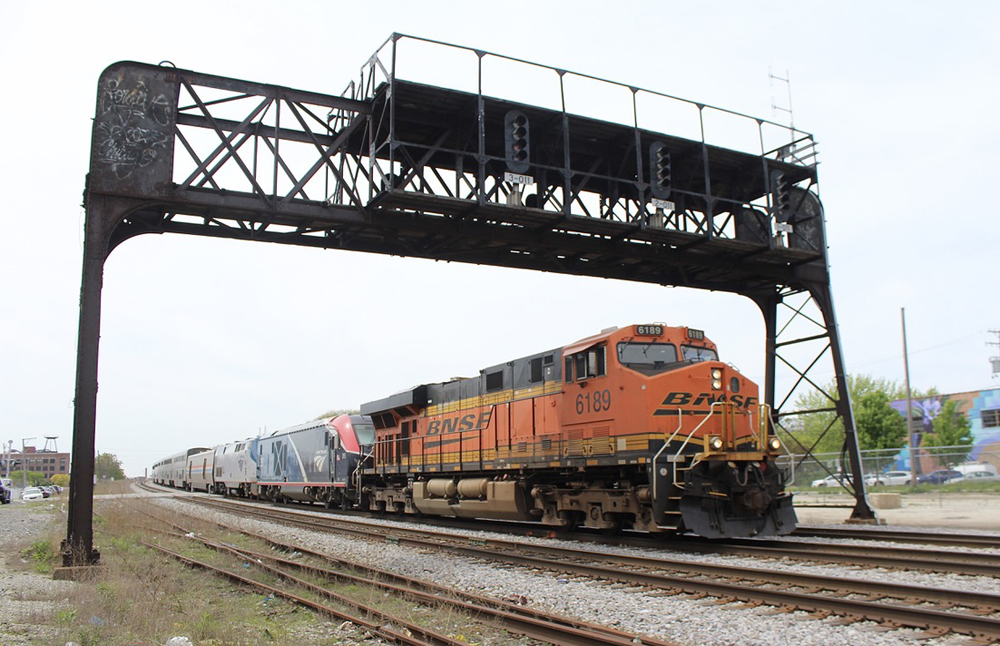
CHICAGO — Some Amtrak long-distance and regional trains outside the Northeast Corridor experienced rare detours and extraordinary delays prior to and during the Memorial Day holiday weekend. On most routes, though, trains were operating on time as a result of lighter freight traffic.
California Zephyrs rerouted
Early Saturday, May 27, a washout on BNSF Railway’s main line east of Denver forced a rare, last-minute California Zephyr detour over Union Pacific’s Overland Route between Denver and Omaha while causing cancellation of the following day’s trains east of the Mile-High City. Each diverted train lost more than 4hours on the detours, which operated via Cheyenne. Both arrived into their terminals almost 6 hours late.
The previous week, on May 17, another washout further east of the Saturday incident forced both Zephyrs to take another overnight Denver-Omaha bypass, this time through Alliance, Neb., over BNSF’s Brush, Angora, Sandhills and Ravenna subdivisions.
Passengers traveling on eastbound train No. 6 that had left Emeryville, Calif., May 16 had already been bus-bridged between Grand Junction, Colo., and Denver as a result of a rock slide on the UP’s ex-Rio Grande Moffat Tunnel line. Then they endured another 8-hour detour delay before rejoining the CZ’s regular route at Lincoln, Neb. The train was almost 11 hours late when it reached Chicago at 1:42 a.m. on May 19.
Sunset truncated
Another significant Memorial Day weekend disruption occurred when a vehicle blocked and apparently damaged Union Pacific tracks east of Del Rio, Texas. The eastbound Sunset Limited limped into San Antonio almost 10 hours late Sunday after what had been a mostly punctual journey from Los Angeles. The train terminated in Houston, where the westbound Sunset originated Monday; passengers were bused to and from New Orleans. The Texas Eagle, held for the Sunset’s Chicago-bound coach and sleeping car, departed San Antonio 6 hours late.
State-supported setbacks
Meanwhile, four Amtrak trains in the past week suffered significant mechanical difficulties; three returned to their originating terminals, resulting in long passenger delays or outright cancellations:

— On May 23, the southbound Chicago-Carbondale, Ill., Illini returned to Chicago’s Union Station and departed 3 hours late after an unspecified mechanical failure developed.
— On May 25, eastbound Missouri River Runner No. 316 encountered mechanical problems that caused it to terminate at Warrensburg, Mo. It was towed back to Kansas City, Mo. by River Runner No. 319 from Chicago. With equipment out of position, westbound No. 311 out of St. Louis was cancelled on May 26.
— Northbound Cascades No. 504 with Horizon equipment and a SC44 Charger locomotive broke down north of Kelso-Longview, Wash. on May 26. It was towed back to Portland, Ore. by train No. 517, which had already been delayed more than an hour out of Vancouver, B.C. by “unforeseen trackwork.”
— The same day, Wolverine No. 354 for Pontiac, Mich. departed Chicago more than 3 hours late and didn’t arrive in Detroit until after 3:30 a.m. Saturday morning.
Empire Builder improving
Although the California Zephyr and a small percentage of regional trains encountered a variety of problems over the holiday weekend, the Empire Builder appears to have returned to relative reliability. The eastbound train arrived into Chicago almost 3 hours late Sunday after being delayed by track obstructions in North Dakota and Minnesota. But for the last two weeks, Builders operating over the 2,200-mile route have used recovery time to counteract most routine operating setbacks.

Earlier in May and other months since the beginning of the year, lengthy delays attributed on the “Amtrak Alerts” Twitter feed only to “freight train interference” and “mechanical issues” occurred. The tardiness of both eastbound and westbound Empire Builders was so severe in some instances that it resulted in round-trip cancellations over the entire route.
In an attempt to understand the challenges and causes of disruptions to a daily service rural communities rely on, Trains News Wire had asked Amtrak and BNSF Railway to explain specific operating decisions and delay incidents for Builders leaving their terminals on May 10 and May 12, as well as what both operator and host were doing to improve performance.
One example News Wire asked about was the eastbound Builder arriving Chicago 22 hours late on May 15, led by a BNSF Railway freight locomotive. Without enough available standby equipment, the day’s westbound departure was cancelled as a result.
A BNSF Railway spokeswoman didn’t reply. Amtrak also declined to provide specifics, but did offer this statement more than a week after the inquiry:
“Amtrak and BNSF meet regularly and our operating teams are in constant touch daily. The host railroad report card can be seen as an indicator of the intent of the host railroads … BNSF continues to be a strong performer with the second highest ‘GPA’ of the carriers. While there will be days that are more difficult to stay on schedule, the aggregate data reported monthly paints the most accurate picture of how our trains are performing. Anecdotal information does not.”
The report card does, however, only measures delays attributable to the host railroad, not Amtrak or its equipment. The BNSF power leading two Amtrak locomotives suggest that at least in this instance, the host railroad was likely part of the solution rather than the problem.














Washouts & rock slides are beyond the control of Amtrak but the state supported problems seem to stem from the new Siemans units which even after all this time still can’t seem get them to run properly. I recall the Genesis units had problems at the beginning but they worked them out & they became fairly reliable but I don’t the same will be said of the Chargers I think they will be an ongoing nightmare.
I call these delays Amtrak fiascos. People ask me what I do when I’m caught in these scenarios. My answer is, I ditch the train and fly from the nearest airport. I can’t imagine what Amtrak does when a trainload of passengers arrives into Chicago at 2am. Pete Buttegig claims he is watching airline performance, I think he also needs to monitor Amtrak customer service performance during these constant fiascos.
I fly. In 184 flights on my log, I recall offhand about five delays:
(1) In 1987, Piedmont took a plane out of service but arranged for a flight on Eastern. Got to DTW about four hours late.
(2) Around 1967, Eastern was put into a “holding pattern” over Connecticut until a slot opened up at LGA. So maybe was a half hour late.
(3) Last year, United had mechanical problems with not one but two planes. I got to SeaTac Washington five hours late.
(4) In 2019 Southwest switched around schedules meaning I had to cool my heels at Ronald Reagan National Airport for an hour or two.
(5) In 1966, Eastern had a problem with a plane, repaired it, and we were on our way after maybe an hour.
Point is, NEVER ONCE was I left without transportation.
This is where a good board chair would call an emergency meeting and demand immediate answers from management — not the inane puffery AMTRAK gave Trains.
Interesting that the Zephyr was detoured over UPRR. I didn’t know this was even possible. Is there some sort of protocol arranged in advance to allow for this detour should it become necessary? Did UPRR provide a lead loco and/or a T+E crew?
Are there other Amtrak services that can be rescued by a detour on a parallel route? One that comes to mind is the I-5 corridor at Tacoma, where the old route was resurrected when the new Point Defiance Bypass was taken out of service on the first day.
Reading railroad history there are examples of parallel routes that no longer exist. The New York Central had parallel routes across northern Ohio that have been abandoned, also the Michigan Central across Michigan and southern Ontario that could accommodate detours of the 20th Century (etc.).
Very obscure, some time around 1960, My father returned from New York to Massachusetts on a New Haven Railroad detour via Norwich, coming into Providence from the west. These tracks have been gone for many decades.
Sigh. WE will hardly see detours like in the Old Days; HP&F got removed 1969/70 I think and they old Air Line was the first route restored in 1938. I doubt Amtrak would detour 448/449 between Boston and Framingham via Walpole as they did in 1981 when the old Back Bay was demolished. But that was a scheduled re-route; today they’d annul or bustitute. Now the Downeaster could be re-routed via Reading and has been–but always as a scheduled move rather than an emergency.
In July 1979 I boarded 48/448 in Rochester bound for Boston delayed by five hours. I learned from other passengers they had detoured between Toledo and Cleveland over the Big Four–but of course I hadn’t been on! The Pullman porter did arrange for my space to be ready early so while ticketed Albany-Boston in a roomette I got it just east of Syracuse. The porter graciously put the bed down so I could try a bed between Springfield and Boston. But mileage detours probably won’t happen no mo’!
More Charger failures????